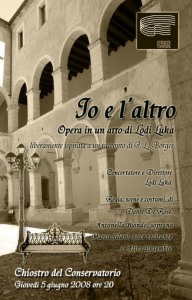Opera in un atto
Libretto di Enrico De Luca
Musica di Lodi Luka
Personaggi
La mamma / La fata: soprano
Clara: bambina
Bruno: bambino
La notte: soprano
Organico strumentale: Flauto, Clarinetto, Pianoforte, Percussioni, Violino, Violoncello
prima esecuzione: Teatro Aroldo Tieri, Cosenza – Aprile 2010
Inizi del XX secolo, Clara e Bruno vivono in una modesta casetta, isolata nel bosco, non hanno amici e usano, come tutti i bambini della loro età, l’immaginazione e la fantasia. È una notte autunnale e i due, si addormentano cullati dalla dolce ninna nanna della loro mamma. All’improvviso sentono rumor di passi fuori dalla casetta, il catenaccio della porta d’ingresso viene forzato ed entra una vecchia curva che dice di essere nientemeno che una fata. I due bambini non le credono, vista la sua bruttezza, ma la vecchia li invita a non fermarsi alle apparenze e, fatta declamare una formula magica, si trasforma in una splendida fata che li guiderà in un viaggio nel misterioso regno della Notte. I bambini vedranno i sogni degli uomini, conosceranno i mali che affliggono il mondo, su tutti il pregiudizio e l’ignoranza, e capiranno che la ricchezza non può dare la felicità e soprattutto quale grande potere abbia l’immaginazione. La Notte vorrebbe trattenerli con forza presso di sé per sempre, ma la Fata la sfida a tocchi di bacchetta… sta per avere la peggio… quand’ecco l’Aurora far capolino tra gli alberi del bosco, foriera di un nuovo giorno, la Notte gradualmente perde i suoi poteri ed è così vinta! I due bimbi si ritrovano nel letto e si risvegliano fra le braccia della loro mamma che ascolta, incredula e al tempo stesso divertita, il racconto del fantastico viaggio.

The Dream
Opera in one act
Libretto by Enrico De Luca
Music of Lodi Luka
Characters
Mom / The Fairy: soprano
Clara: little girl
Bruno: child
The night: soprano
Chorus of elves and goblins
Instrumental ensemble: Flute, Clarinet, Percussion, Piano, Violin, Cello
First performance: Teatro Aroldo Tieri, Cosenza – April 2010
Beginning of the twentieth century, Clara and Bruno live in a modest house, isolated in the woods, have no friends, and used, as all the children of their age, imagination and fantasy. It’s a night and the two fall, fall asleep lulled by the gentle lullaby their mother. Suddenly they hear the sound of footsteps outside the house, the bolt of the front door is forced and enters an old curve that claims to be nothing less than a fairy. The two children do not believe, having regard to its ugliness, but the old urges them not to stop at appearances and, without reciting a magic formula, it turns into a beautiful fairy who will guide you on a journey into the mysterious realm of the Night. The children will see the dreams of men, they know the evils that afflict the world, on all the prejudice and ignorance, and they will realize that wealth can not give happiness and above all as a great power has the imagination. The night would hold them firmly with him forever, but the fairy wand touches to the challenge … is going to get worse … when suddenly the Aurora to peep through the trees of the forest, the harbinger of a new day, the Night gradually loses his powers and is so won! The two children find themselves in bed and wake up in the arms of their mother who listens, incredulous and amused at the same time, the story of the fantastic trip.
Opera in un atto, liberamente ispirata a un racconto dello scrittore argentino Jorge Luis Borges
Personaggi:
L’Anziano: Voce recitante maschile
L’Altro: Soprano
Ambientazione: Cambridge, nel febbraio 1972
Organico strumentale: Flauto, Clarinetto, Pianoforte, Percussioni, Violino, Violoncello
Prima rappresentazione: Conservatorio di Cosenza, 2008
Due i personaggi: l’anziano e l’altro, interpretati da un attore e un soprano. Il tema trattato è l’incontro, vissuto come un sogno, di un uomo anziano con se stesso giovane. L’anziano accetta il sogno con naturalezza e vive l’incontro come un fatto reale, il giovane di contro vive l’impossibile con una certa paura. L’anziano racconta al giovane del suo futuro, ma lui quasi non lo ascolta. Mezzo secolo divide i due protagonisti e li rende diversi, rendendo molto difficile anche il dialogo. I due si lasciano freddamente con la vana promessa di incontrarsi di nuovo il giorno dopo.
Si tratta di un’opera in cui la musica sottolinea il carattere surreale del testo e scava nella psicologia dei due protagonisti che rappresentano in realtà due fasi vitali di un unico personaggio.

Io e l’altro/Me and the other (opera in one act) fragment
Me and the other
Opera in one act, loosely based on a story by Argentine writer Jorge Luis Borges
Characters:
The Elder: Male Voice Over
The Other: Soprano
Setting: Cambridge, February 1972
Instrumental ensemble: Flute, Clarinet, Piano, Percussion, Violin, Cello
First performance at the Conservatory of Cosenza, 2008
Two characters: the elderly and the other, played by an actor and a soprano. The theme of the meeting is experienced as a dream, an old man with himself young. Elder accepts the dream lives naturally and the meeting as a real fact, the young man lives against the impossible with a certain fear. The old man tells the young man of his future, but he almost did not listen to him. Half a century separates the two main characters and makes them different, making it very difficult dialogue as well. The two are left cold with the vain promise to meet again the next day.
It is a work in which the music emphasizes the surreal character of the text and delves into the psychology of the two protagonists that are actually two life stages of a single character.